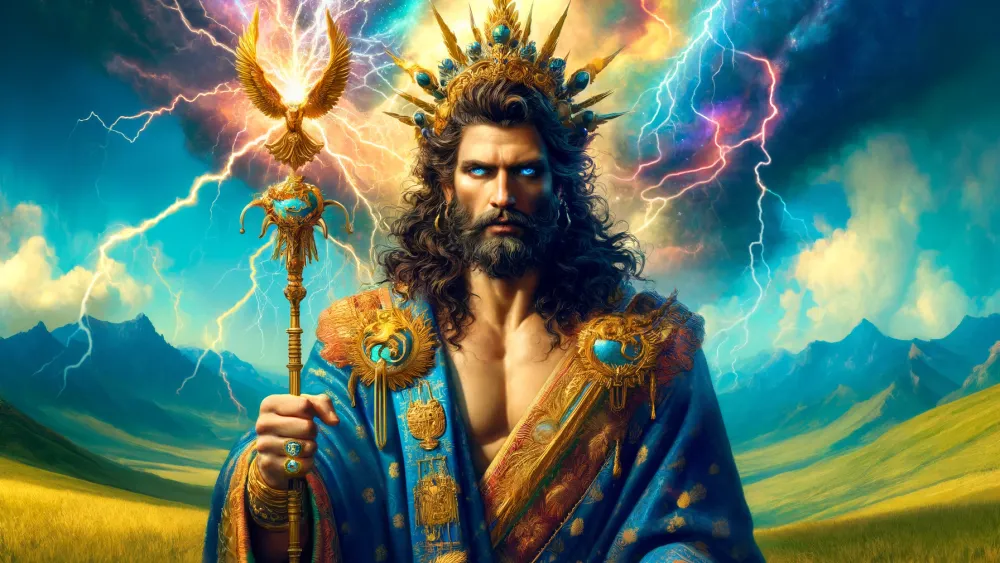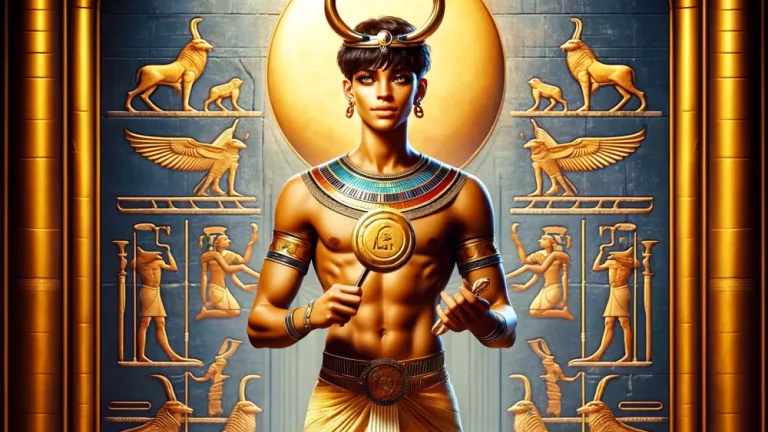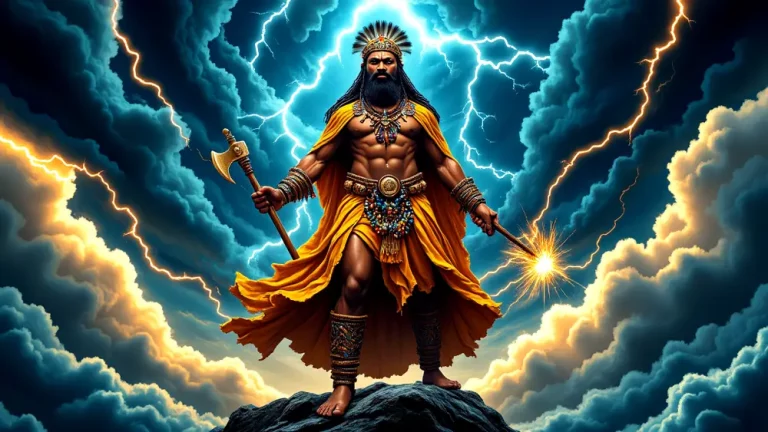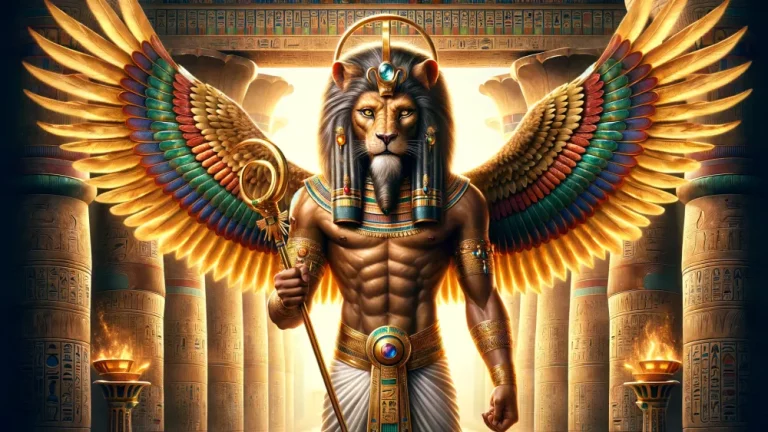Baal: Canaanite God Of Fertility And Weather
Baal, a big name in ancient Near Eastern religions, is often linked with fertility, weather, and good harvests. Revered mainly in the Canaanite pantheon, Baal’s reach spreads to Mesopotamians, Egyptians, and Israelites. This blog dives into all things Baal – his beginnings, roles, and why he matters across different places and beliefs.
Key Points:
- Baal is an ancient Canaanite god linked to fertility, weather, and agriculture.
- He was worshipped in various cultures including Mesopotamians, Egyptians, and Israelites.
- Baal’s roles include being a storm god, fertility deity, protector, and warrior.
- The Baal Cycle, a series of stories, emphasizes his battles and rise to power.
- Baal’s influence extended to neighboring cultures like Egypt, where he was integrated into their pantheon.
- In modern times, Baal appears in literature, media, and modern religious and occult practices.
- Baal’s symbols include the bull, thunderbolt, and club; and he is often linked with temples and specific epithets and titles.
We look at old texts, digs from the past, and modern takes to give you a full picture of Baal’s lasting mark on history. Consequently, you’ll see how he shapes both ancient times and today’s world.
Baal: Overview and Key Facts
| Aspect | Details |
|---|---|
| Name | Baal (also spelled Ba’al) |
| Meaning of Name | “Lord” or “Master” |
| Pantheon | Canaanite, but also worshipped in Mesopotamian, Egyptian, and Israelite cultures |
| Primary Roles | God of fertility, weather, and agriculture |
| Symbols | Bull, thunderbolt, and staff |
| Major Texts | The Baal Cycle (Ugaritic texts) |
| Key Attributes | Power over storms, rain, and agricultural fertility |
| Main Temples | Baalbek (Lebanon) Ugarit (Syria) Hazor (Israel) |
| Epithets | Baal Hadad, Baal Zephon, Baal Shamin |
| Associated Deities | Anat (sister and consort) El (father) Yam (sea god, rival) |
| Cultural Influence | Big impact on neighboring cultures. He appears in literature, films, and modern religious practices |
Conflicts with Yahweh worship in the Hebrew Bible. Often depicted with a horned helmet holding a thunderbolt or staff. This table gives you a detailed look at who Baal is. It covers his name roles symbols major texts more so you get a full picture of this ancient god.
The Origins of Baal
To get Baal’s story, we need to see where he starts. For instance, let’s look at his beginnings in Mesopotamia and the Levant.
Mesopotamian Beginnings
Baal first shows up in Mesopotamian texts, often mentioned with other gods. These early mentions make him a big deal, though not always the top god. For instance, some texts call Baal a storm god who controls rain and thunder. This role matters a lot because farming needs water. As for farmers and communities, they rely on his power to bring rain.
Meanwhile, Baal’s name appears in many inscriptions (and tablets), showing he is worshipped widely across different city-states.
In Mesopotamian culture, Baal has several key roles and traits. He mainly acts as a storm god and a fertility deity. These roles mean he handles both weather and crop growth. Furthermore, people often show him with a thunderbolt or riding a bull, symbols of his strength:
- Storm God: Controls rain and lightning.
- Fertility Deity: Helps crops grow.
- Protector: Guards against disasters.
- Warrior: Fights battles bravely.
These traits make Baal important for both nature and human life since he influences so much around them every day.
Baal plays crucial roles as a storm god, fertility deity, protector, and warrior, impacting nature and human life significantly.
Baal in the Levant
Baal holds a special place in the Levant region (modern-day Lebanon, Syria, Jordan, and Israel). In particular, he stands out as a powerful god who controls both weather and fertility. This makes him crucial for farming and daily life. For instance, farmers pray to Baal for rain so their crops grow well.
At the same time, his role as a storm god means he can protect or harm communities based on his mood. Consequently, people offer sacrifices and perform rituals to keep him happy.
Different city-states and cultures in the Levant worship Baal:
- Ugarit: A major city-state where Baal is chief.
- Byblos: Another important city that honors him.
- Sidon: Known for its devotion to Baal.
- Tyre: Worships him as a key deity.
- Hazor: An Israelite city that also reveres him.
These places show how widespread his worship is across the Levant since each has its own temples and rituals dedicated to him. As for daily lives there, they highlight just how important he really is.
Baal’s significance in the Levant region lies in his control over weather and fertility which directly impacts farming and daily life, leading to widespread worship and elaborate rituals in various city-states and cultures.
Baal’s Role in Canaanite Religion
Given that Baal is so important in the Levant, his role in Canaanite religion becomes even more significant. Let’s dive into how he shapes their beliefs and practices.
The Baal Cycle
The Baal Cycle is a series of old stories from Ugarit (a city-state in modern-day Syria). These texts, written in the Ugaritic language, tell about Baal’s adventures and rise to power. They are found on clay tablets and date back to the 14th century BCE. The Baal Cycle includes several key episodes that show Baal as a storm god and fertility deity.
These stories help us understand Canaanite religion and how they see their gods. The main themes in the Baal Cycle revolve around conflict, power, and renewal. One important story is Baal’s battle with Yam (the sea god). He defeats Yam, showing his control over chaotic forces of nature. Another key story involves his fight with Mot (the god of death).
His temporary death and return symbolize the cycle of seasons and agricultural renewal. These themes highlight his role in keeping order and ensuring land fertility. Baal’s battles with other deities are crucial for his rise to prominence.
For instance, he wins against Yam which makes him supreme god of storms and rain since it shows his power over the sea’s destructive potential. Meanwhile, his struggle with Mot highlights his role in life cycles because even though he dies, he returns to life symbolizing nature’s renewal.
Baal as a Fertility God
Baal is closely linked to fertility and farming in Canaanite religion. As a storm god, he controls rain, which is crucial for growing crops. Farmers depend on him to bring rain at the right times so their fields stay fertile. Without his help, crops could fail and lead to famine.
Given that Baal’s story of death and resurrection (as seen in the Baal Cycle) symbolizes the seasonal cycle of planting and harvest, he becomes key for ensuring land productivity. To ensure Baal’s favor, people perform various rituals and offerings. They build altars and temples where they present sacrifices like animals or grain because these offerings please him and encourage him to send rain.
For instance, during droughts special ceremonies might be held asking for his intervention. Furthermore, festivals celebrating Baal often include music, dance, and prayers to honor him while seeking his blessings since these practices show how deeply Canaanites rely on Baal for agricultural success.
Baal’s Influence in Neighboring Cultures
Even though Baal plays a huge role in Canaanite religion, his impact doesn’t stop there. Let’s explore how he shapes beliefs in nearby cultures.
Baal in Ancient Egypt
Baal’s integration into Egyptian mythology happens during the New Kingdom period (around 1550-1070 BCE). Egyptians start mentioning Baal, especially in contexts related to war and storms. They see him as a powerful foreign god and adopt him into their own pantheon. For instance, they often show him as a warrior with a mace and horned helmet, which highlights his strength.
This adoption reflects cultural exchanges between Egypt and the Levant where Baal is already well-known. The syncretism between Baal and Set is particularly interesting. Set, originally a god of chaos and storms, shares many traits with Baal. Consequently, Egyptians begin to merge them because they see them as different sides of the same divine force. For example, both gods are linked to storms and deserts, having roles that include protective yet destructive elements.
This blending shows how ancient cultures adapt foreign deities into their own beliefs for creating richer mythologies.
Egyptians integrate the foreign god Baal into their pantheon during the New Kingdom period, merging him with their own god Set due to overlapping traits and beliefs.
Baal in the Bible
In the Hebrew Bible, Baal often gets a bad rap. He is seen as a rival to Yahweh, Israel’s God. For instance, Elijah on Mount Carmel (1 Kings 18) shows this rivalry clearly. Elijah challenges Baal’s prophets to call down fire from heaven. They fail miserably while Yahweh sends fire instantly. This story highlights Baal’s weakness and Yahweh’s power.
Conflicts between worship of Baal and Yahweh pop up frequently in the Hebrew Bible. Israelites often turn to Baal during tough times or when influenced by neighbors. For example, Judges 2:11-13 says they “did evil” by serving Baal and Ashtoreth (another deity). This leads to punishment and calls for repentance.
Prophets constantly condemn Baal worship, seeing it as a big threat to their covenant with Yahweh because it pulls people away from true faith.

Worship and Iconography of Baal
Given that Baal’s influence is widespread, it’s key to see how people worship him. For instance, let’s explore his temples and artistic depictions.
Temples and Sacred Sites
Major temples dedicated to Baal pop up in various regions. For instance, the Temple of Baal in Ugarit (modern-day Ras Shamra, Syria) stands out as a key site. Another famous one is the Temple of Baalbek in Lebanon, which later becomes known as Heliopolis under Roman rule. Meanwhile, Palmyra in Syria houses the well-known Temple of Bel.
These places serve as central spots for worship and community gatherings. The architectural features of these temples are quite impressive and hold great significance. For example, the Temple of Baal in Ugarit has a large courtyard and high altar – typical elements in Canaanite temple design. The Temple of Baalbek showcases massive stone columns and intricate carvings because it reflects both local and Roman influences.
As for the Temple of Bel in Palmyra, it includes a grand entrance and sanctuary (or cella) where Baal’s statue resides. These features highlight not only the importance of Baal worship but also show cultural exchanges between different civilizations.
- Large courtyards
- High altars
- Massive stone columns
- Intricate carvings
- Grand entrances
- Sanctuaries (cella)
Symbols and Representations of Baal
Common symbols tied to Baal include the bull, which stands for strength and fertility. Another key symbol is the thunderbolt because it highlights his role as a weather god. At the same time, Baal often links with the club or mace, showing his power in battle. These symbols pop up frequently in ancient texts and artifacts, reinforcing Baal’s attributes and roles in mythology.
Artistic depictions of Baal in ancient artifacts are quite detailed. For instance, Ugaritic art often shows him holding a thunderbolt in one hand and a club in the other. He usually wears a horned helmet to signify his divine status. In some carvings, he stands on a bull to emphasize his connection to fertility and strength. These depictions help us see how ancient people viewed Baal’s power and importance.
- Bull
- Thunderbolt
- Club or mace
- Horned helmet
Baal’s Epithets and Titles
Given that Baal has many roles, he also has numerous epithets and titles. These names show his diverse powers and importance.
Common Epithets of Baal
Baal goes by many names, each showing a different side of him. Some common ones include Baal Hadad (the storm god), Baal Zaphon (lord of the north), and Baal Shamem (lord of the heavens). These names pop up in various ancient texts and inscriptions, showing how people saw him in different ways.
For instance, Baal Hadad highlights his control over storms and rain, which are crucial for farming. Meanwhile, Baal Zaphon ties him to Mount Zaphon, a sacred mountain. The meanings and contexts of these epithets offer insights into Baal’s roles. For example, Baal Hadad, often just called Hadad, is very important in areas that rely on rainfall for crops. This name underscores his role as a fertility god.
At the same time, Baal Zaphon reflects his link with a specific place because local cultures adapted his worship to their needs. Furthermore, Baal Shamem highlights his celestial aspect since it links him to the sky and weather phenomena. These epithets help us understand both the multifaceted nature of Baal and how different communities venerated him.
The various names of Baal, such as Baal Hadad, Baal Zaphon, and Baal Shamem, reveal different aspects of his identity and roles which were interpreted by different ancient communities.
Baal’s Role as a Weather God
Baal controls weather phenomena, especially storms and rain. He often holds a thunderbolt in one hand and a club in the other, showing his power over the skies. In particular, Baal’s ability to bring rain is crucial for farming since many ancient societies depend on seasonal rains for their crops. Consequently, people see him as a life-giver and protector.
For instance, in the Baal Cycle (a series of Ugaritic texts), Baal fights the sea god Yam and death god Mot to show his dominance over nature. The importance of Baal’s weather powers in ancient societies can’t be overstated. Given that many regions experience dry spells and droughts, Baal’s control over rain is vital for survival.
Farmers pray to him for rain to nourish their fields while communities hold festivals and offer sacrifices to keep him happy. As for his broader impact, Baal’s role as a weather god reinforces his position as a central deity in Canaanite religion because he can control such essential elements of life. His ability to manage the weather makes him powerful since it shapes how people understand nature.
Baal in Modern Culture
Even though Baal’s ancient roots run deep, his influence continues today. So, let’s explore how Baal appears in modern times.
Baal in Literature and Media
Baal shows up in many modern books and films. In particular, he often appears as a powerful and sometimes evil figure. For instance, in the TV show “Supernatural,” Baal is a demon, showing a darker side. Meanwhile, in books like “The Lesser Key of Solomon,” Baal is listed as one of the demons King Solomon controls.

These portrayals highlight how his image shifts from an ancient god to a character in today’s stories. Consequently, he becomes a symbol of power and mystery that fits well into fantasy and horror genres. Baal’s image changes a lot in contemporary culture. While old texts depict him as a storm and fertility god, modern media often reimagines him as dark or powerful.
This shift likely happens because different mythologies blend together for compelling story villains. For instance, in video games like “Smite,” Baal appears as a playable character with divine powers shown anew. As for this evolution, it keeps his story alive by fitting ancient attributes into fresh contexts relevant today since myths adapt over time naturally.
Baal in Popular Religion and Occultism
Baal plays a big role in modern religious and occult practices. In particular, some pagan groups today include Baal as a nature and storm god. For instance, they might invoke him for protection or to control natural forces. Meanwhile, in occult circles, Baal often appears in grimoires (magic books) where people call on him for power and knowledge.
Consequently, his ancient traits find new life by blending old beliefs with today’s spiritual needs. The interest in Baal grows within new religious movements. Given that many seek ancient traditions, Baal’s image appeals as a powerful deity. For instance, some modern witches (like Wiccans) may use Baal in their rituals to tap into his old powers.
At the same time, the internet spreads information about him widely so more people learn about this ancient god easily now. As for how myths adapt over time naturally? They fit into today’s spiritual landscapes well because of this ongoing fascination with figures like Baal.
FAQs
1. Who was Baal in ancient mythology?
Baal in ancient mythology was a prominent Canaanite god associated with fertility, weather, and storms.
2. How did Baal influence other cultures?
Baal influenced other cultures by being integrated into their pantheons and mythologies, often merging with or being equated to local deities.
3. What are the main stories in the Baal Cycle?
The main stories in the Baal Cycle include Baal’s battles with the sea god Yam and the death god Mot, as well as his eventual rise to kingship among the gods.
4. How is Baal depicted in modern media?
Baal is depicted in modern media often as a powerful and malevolent deity, reflecting his ancient associations with storms and chaos.







